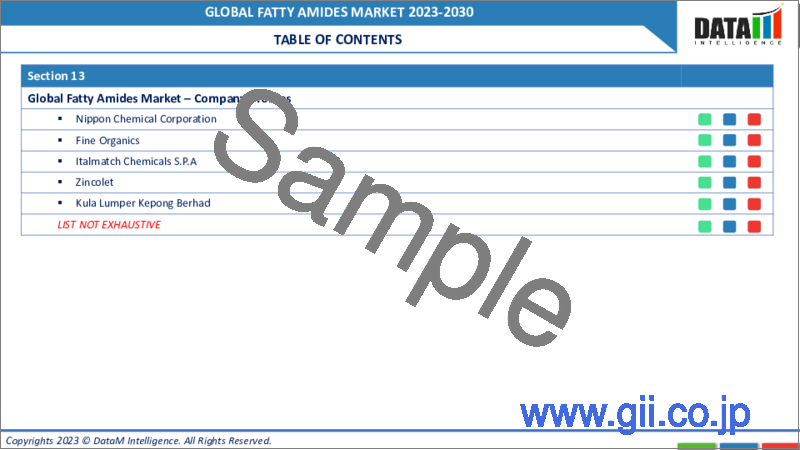|
|
市場調査レポート
商品コード
1255857
脂肪酸アミドの世界市場-2023-2030Global Fatty Amides Market - 2023-2030 |
||||||
|
● お客様のご希望に応じて、既存データの加工や未掲載情報(例:国別セグメント)の追加などの対応が可能です。 詳細はお問い合わせください。 |
|||||||
| 脂肪酸アミドの世界市場-2023-2030 |
|
出版日: 2023年04月11日
発行: DataM Intelligence
ページ情報: 英文 219 Pages
納期: 約2営業日
|
- 全表示
- 概要
- 目次
市場概要
世界の脂肪酸アミド市場は、予測期間(2023-2030年)中に4.32%のCAGRで成長する見通しです。
脂肪酸アミドは、動植物性油脂や合成界面活性剤、潤滑油など、多くの天然および合成ソースに含まれています。脂肪酸アミドの例としては、ラウラミド、ミリスタミド、ステアリン酸アミドなどがあります。脂肪酸アミドは、様々な産業で幅広い用途に使用されています。食品・化粧品業界では、乳化剤、潤滑剤、界面活性剤として使用されています。
市場力学
潤滑油や界面活性剤としての性質を持つ脂肪酸アミドは、包装食品分野でますます需要が高まっている
脂肪酸アミドは、環境に悪影響を及ぼす可能性のある合成潤滑油に代わる天然の潤滑油として使用することができます。パッケージ食品業界における脂肪酸アミドの需要は、自然食品やオーガニック食品に対する消費者の需要の高まりにより増加しています。消費者は自分が口にする食材への意識が高まり、人工成分や防腐剤を含まない製品を求めるようになってきています。脂肪酸アミドは合成乳化剤に代わる天然の乳化剤であり、消費者にとってより健康的であると考えられています。
さらに、合成乳化剤や潤滑油の環境への影響に対する懸念が高まっていることも、食品業界における脂肪酸アミドの需要を後押ししています。脂肪酸アミドは生分解性があり、合成乳化剤や潤滑油に比べて環境負荷が低いです。
市場における合成樹脂の代替品の存在
主な抑制要因のひとつは、他の界面活性剤や乳化剤との競合が激化していることです。環境と健康に対する意識と懸念の高まりにより、化学ベースの脂肪酸アミドよりも安価で持続可能なバイオベースおよび天然界面活性剤への移行が進んでいます。脂肪酸アミドの需要減少につながる可能性があります。
COVID-19の影響分析
COVID-19分析では、COVID前シナリオ、COVIDシナリオ、COVID後シナリオに加え、価格力学(パンデミック時やCOVID前シナリオとの比較による価格変動を含む)、需要-供給スペクトラム(取引制限、封鎖、その後の問題による需要と供給のシフト)、政府の取り組み(政府機関による市場、セクター、産業の活性化に関する取り組み)、メーカーの戦略的取り組み(COVID問題を軽減するためのメーカーの取り組み)についても解説しています。
目次
第1章 調査手法とスコープ
- 調査手法
- 調査目的および調査範囲について
第2章 定義と概要
第3章 エグゼクティブサマリー
- タイプ別スニペット
- 製品形態別スニペット
- 機能別スニペット
- アプリケーション別スニペット
- 地域別スニペット
第4章 市場力学
- 影響要因
- 促進要因
- 潤滑油や界面活性剤としての性質を持つ脂肪酸アミドは、包装食品分野でますます需要が高まっている
- 抑制要因
- 合成代替品の存在
- 機会
- 影響度分析
- 促進要因
第5章 産業分析
- ポーターのファイブフォース分析
- サプライチェーン分析
- 価格アナリシス
- レギュラトリー・アナリシス
第6章 COVID-19の分析
- COVID-19の解析について
- COVID-19シナリオ前
- 現在のCOVID-19シナリオ
- ポストCOVID-19またはフューチャーシナリオ
- COVID-19における価格ダイナミクス
- 需給スペクトル
- パンデミック時の市場に関連する政府の取り組み
- メーカーの戦略的な取り組み
- 結論
第7章 タイプ別
- エルカミド
- ベヘンアミド
- オレアミド
- その他
第8章 製品形態別
- ビーズ
- パウダー
第9章 機能別
- スリップ剤
- 粘着防止剤
- 離型剤
第10章 アプリケーション別
- フィルム加工
- ラバー
- インク
- その他
第11章 地域別
- 北米
- 米国
- カナダ
- メキシコ
- 欧州
- ドイツ
- 英国
- フランス
- イタリア
- ロシア
- その他欧州
- 南米
- ブラジル
- アルゼンチン
- その他南米地域
- アジア太平洋地域
- 中国
- インド
- 日本
- オーストラリア
- その他アジア太平洋地域
- 中東・アフリカ地域
第12章 競合情勢
- 競合シナリオ
- 市況分析・シェア分析
- M&A分析
第13章 企業プロファイル
- Coroda International Plc
- 会社概要
- 製品ポートフォリオと説明
- 財務概要
- 主な展開
- Mitsubishi Chemical Corporation
- KLF OLEO
- PMC Group, Inc.
- Kao Corporation
- Nippon Chemical Corporation
- Fine Organics
- Italmatch Chemicals S.P.A
- Zincolet
- Kula Lumper Kepong Berhad
第14章 付録
Market Overview
The global fatty amides market reached US$ XX million in 2022 and is projected to witness lucrative growth by reaching up to US$ XX million by 2030. The market is growing at a CAGR of 4.32% during the forecast period (2023-2030).
Fatty amides are found in many natural and synthetic sources, including in animal and plant fats and oils, as well as in synthetic surfactants and lubricants. Some examples of fatty amides include lauramide, myristamide and stearamide. Fatty amides hold a wide range of applications in various industries. It are used as emulsifiers, lubricants and surfactants in the food and cosmetic industry.
Market Dynamics
Due to their lubricants and surfactant qualities, fatty amides are becoming more and more in demand in the packaged food sectors
Fatty amides can be used as a natural alternative to synthetic lubricants, which can harm the environment. The demand for fatty amides in the packaged food industry is increasing due to the growing consumer demand for natural and organic food products. Consumers is becoming more conscious of the ingredients they eat and looking for products free from artificial ingredients and preservatives. Fatty amides are a natural alternative to synthetic emulsifiers and are considered healthier for consumers.
Furthermore, the increasing concerns about the environmental impact of synthetic emulsifiers and lubricants are also driving the demand for fatty amides in the food industry. Fatty amides are biodegradable and have a lower environmental impact than synthetic emulsifiers and lubricants.
Presence of sythetic alternatives in the market
One of the major restraining factor is the increasing competition from other surfactants and emulsifiers. Due to the growing awareness and concerns about the environment and health, there is a shift towards bio-based and natural surfactants, which can be less expensive and more sustainable than chemical-based fatty amides. It can lead to a decrease in demand for fatty amides.
COVID-19 Impact Analysis
The COVID-19 Analysis includes Pre-COVID Scenario, COVID Scenario and Post-COVID Scenario along with Pricing Dynamics (Including pricing change during and post-pandemic comparing it with pre-COVID scenarios), Demand-Supply Spectrum (Shift in demand and supply owing to trading restrictions, lockdown and subsequent issues), Government Initiatives (Initiatives to revive market, sector or Industry by Government Bodies) and Manufacturers Strategic Initiatives (What manufacturers did to mitigate the COVID issues will be covered here).
Segment Analysis
The global fatty amides market is segmented based on type, product form, function, application and region.
Growing demand for fatty amides in the manufacturing and processing of films processing application
Several factors drive the demand for fatty amides in film processing. One of the major factors is the growing demand for plastic films in various industries. Plastic films are used in packaging, agriculture, construction and many other industries and the demand for these films are increasing. The respective increased demand for plastic films drives the demand for fatty amides as lubricants and release agents in the film processing industry.
Geographical Analysis
The introduction of strict norms and laws to limit GHG emissions
The increasing focus on sustainability and environmental protection in Asia-Pacific drives the demand for fatty amides. Fatty amides are considered more environmentally friendly than many other lubricants and release agents commonly used in the region. They are biodegradable and have a lower environmental impact than synthetic lubricants and release agents. As a result, as Asia-Pacific is catching upto other regions in terms of sustainability and environment protection, the demand for fatty acids is expected to grow, allowing the region to dominate the market.
Competitive Landscape
The major global players include: Croda International Plc, Mitsubish Chemical Corporation, KLF OLEO, PMC Group,Inc., Kao Corporation, Nippon Chemical Corporation, Fine Organics, Italmatch Chemicals S.P.A, Zincolet and Kula Lumper Kepong Berhad.
Why Purchase the Report?
- To visualize the global fatty amides market segmentation based on type, product form, function, application and region, as well as understand key commercial assets and players.
- Identify commercial opportunities by analyzing trends and co-development.
- Excel data sheet with numerous data points of fatty amides market-level with all segments.
- PDF report consists of a comprehensive analysis after exhaustive qualitative interviews and an in-depth study.
- Product mapping available as excel consisting of key products of all the major players.
The global fatty amides market report would provide approximately 69 tables, 67 figures and 219 Pages.
Target Audience 2023
- Manufacturers/ Buyers
- Industry Investors/Investment Bankers
- Research Professionals
- Emerging Companies
Table of Contents
1. Methodology and Scope
- 1.1. Research Methodology
- 1.2. Research Objective and Scope of the Report
2. Definition and Overview
3. Executive Summary
- 3.1. Snippet by Type
- 3.2. Snippet by Product Form
- 3.3. Snippet by Function
- 3.4. Snippet by Application
- 3.5. Snippet by Region
4. Dynamics
- 4.1. Impacting Factors
- 4.1.1. Drivers
- 4.1.1.1. Due to their lubricants and surfactant qualities, fatty amides are becoming more and more in demand in the packaged food sectors
- 4.1.1.2. XX
- 4.1.2. Restraints
- 4.1.2.1. Presence of synthetic alternatives
- 4.1.2.2. XX
- 4.1.3. Opportunity
- 4.1.3.1. XX
- 4.1.4. Impact Analysis
- 4.1.1. Drivers
5. Industry Analysis
- 5.1. Porter's Five Forces Analysis
- 5.2. Supply Chain Analysis
- 5.3. Pricing Analysis
- 5.4. Regulatory Analysis
6. COVID-19 Analysis
- 6.1. Analysis of COVID-19
- 6.1.1. Before COVID-19 Scenario
- 6.1.2. Present COVID-19 Scenario
- 6.1.3. Post COVID-19 or Future Scenario
- 6.2. Pricing Dynamics Amid COVID-19
- 6.3. Demand-Supply Spectrum
- 6.4. Government Initiatives Related to the Market During Pandemic
- 6.5. Manufacturers Strategic Initiatives
- 6.6. Conclusion
7. By Type
- 7.1. Introduction
- 7.1.1. Market Size Analysis and Y-o-Y Growth Analysis (%), By Type
- 7.1.2. Market Attractiveness Index, By Type
- 7.2. Erucamide*
- 7.2.1. Introduction
- 7.2.2. Market Size Analysis and Y-o-Y Growth Analysis (%)
- 7.3. Behenamide
- 7.4. Oleamide
- 7.5. Others
8. By Product Form
- 8.1. Introduction
- 8.1.1. Market Size Analysis and Y-o-Y Growth Analysis (%), By Product Form
- 8.1.2. Market Attractiveness Index, By Product Form
- 8.2. Bead*
- 8.2.1. Introduction
- 8.2.2. Market Size Analysis and Y-o-Y Growth Analysis (%)
- 8.3. Powder
9. By Function
- 9.1. Introduction
- 9.1.1. Market Size Analysis and Y-o-Y Growth Analysis (%), By Function
- 9.1.2. Market Attractiveness Index, By Function
- 9.2. Slip Agent*
- 9.2.1. Introduction
- 9.2.2. Market Size Analysis and Y-o-Y Growth Analysis (%)
- 9.3. Anti Block
- 9.4. Release Agent
10. By Application
- 10.1. Introduction
- 10.1.1. Market Size Analysis and Y-o-Y Growth Analysis (%), By Application
- 10.1.2. Market Attractiveness Index, By Application
- 10.2. Film processing*
- 10.2.1. Introduction
- 10.2.2. Market Size Analysis and Y-o-Y Growth Analysis (%)
- 10.3. Rubber
- 10.4. Ink
- 10.5. Others
11. By Region
- 11.1. Introduction
- 11.1.1. Market Size Analysis and Y-o-Y Growth Analysis (%), By Region
- 11.1.2. Market Attractiveness Index, By Region
- 11.2. North America
- 11.2.1. Introduction
- 11.2.2. Key Region-Specific Dynamics
- 11.2.3. Market Size Analysis and Y-o-Y Growth Analysis (%), By Type
- 11.2.4. Market Size Analysis and Y-o-Y Growth Analysis (%), By Product Form
- 11.2.5. Market Size Analysis and Y-o-Y Growth Analysis (%), By Function
- 11.2.6. Market Size Analysis and Y-o-Y Growth Analysis (%), By Application
- 11.2.7. Market Size Analysis and Y-o-Y Growth Analysis (%), By Country
- 11.2.7.1. U.S.
- 11.2.7.2. Canada
- 11.2.7.3. Mexico
- 11.3. Europe
- 11.3.1. Introduction
- 11.3.2. Key Region-Specific Dynamics
- 11.3.3. Market Size Analysis and Y-o-Y Growth Analysis (%), By Type
- 11.3.4. Market Size Analysis and Y-o-Y Growth Analysis (%), By Product Form
- 11.3.5. Market Size Analysis and Y-o-Y Growth Analysis (%), By Function
- 11.3.6. Market Size Analysis and Y-o-Y Growth Analysis (%), By Application
- 11.3.7. Market Size Analysis and Y-o-Y Growth Analysis (%), By Country
- 11.3.7.1. Germany
- 11.3.7.2. UK
- 11.3.7.3. France
- 11.3.7.4. Italy
- 11.3.7.5. Russia
- 11.3.7.6. Rest of Europe
- 11.4. South America
- 11.4.1. Introduction
- 11.4.2. Key Region-Specific Dynamics
- 11.4.3. Market Size Analysis and Y-o-Y Growth Analysis (%), By Type
- 11.4.4. Market Size Analysis and Y-o-Y Growth Analysis (%), By Product Form
- 11.4.5. Market Size Analysis and Y-o-Y Growth Analysis (%), By Function
- 11.4.6. Market Size Analysis and Y-o-Y Growth Analysis (%), By Application
- 11.4.7. Market Size Analysis and Y-o-Y Growth Analysis (%), By Country
- 11.4.7.1. Brazil
- 11.4.7.2. Argentina
- 11.4.7.3. Rest of South America
- 11.5. Asia-Pacific
- 11.5.1. Introduction
- 11.5.2. Key Region-Specific Dynamics
- 11.5.3. Market Size Analysis and Y-o-Y Growth Analysis (%), By Type
- 11.5.4. Market Size Analysis and Y-o-Y Growth Analysis (%), By Product Form
- 11.5.5. Market Size Analysis and Y-o-Y Growth Analysis (%), By Function
- 11.5.6. Market Size Analysis and Y-o-Y Growth Analysis (%), By Application
- 11.5.7. Market Size Analysis and Y-o-Y Growth Analysis (%), By Country
- 11.5.7.1. China
- 11.5.7.2. India
- 11.5.7.3. Japan
- 11.5.7.4. Australia
- 11.5.7.5. Rest of Asia-Pacific
- 11.6. Middle East and Africa
- 11.6.1. Introduction
- 11.6.2. Key Region-Specific Dynamics
- 11.6.3. Market Size Analysis and Y-o-Y Growth Analysis (%), By Type
- 11.6.4. Market Size Analysis and Y-o-Y Growth Analysis (%), By Product Form
- 11.6.5. Market Size Analysis and Y-o-Y Growth Analysis (%), By Function
- 11.6.6. Market Size Analysis and Y-o-Y Growth Analysis (%), By Application
12. Competitive Landscape
- 12.1. Competitive Scenario
- 12.2. Market Positioning/Share Analysis
- 12.3. Mergers and Acquisitions Analysis
13. Company Profiles
- 13.1. Coroda International Plc*
- 13.1.1. Company Overview
- 13.1.2. Product Portfolio and Description
- 13.1.3. Financial Overview
- 13.1.4. Key Developments
- 13.2. Mitsubishi Chemical Corporation
- 13.3. KLF OLEO
- 13.4. PMC Group, Inc.
- 13.5. Kao Corporation
- 13.6. Nippon Chemical Corporation
- 13.7. Fine Organics
- 13.8. Italmatch Chemicals S.P.A
- 13.9. Zincolet
- 13.10. Kula Lumper Kepong Berhad
LIST NOT EXHAUSTIVE
14. Appendix
- 14.1. About Us and Services
- 14.2. Contact Us




